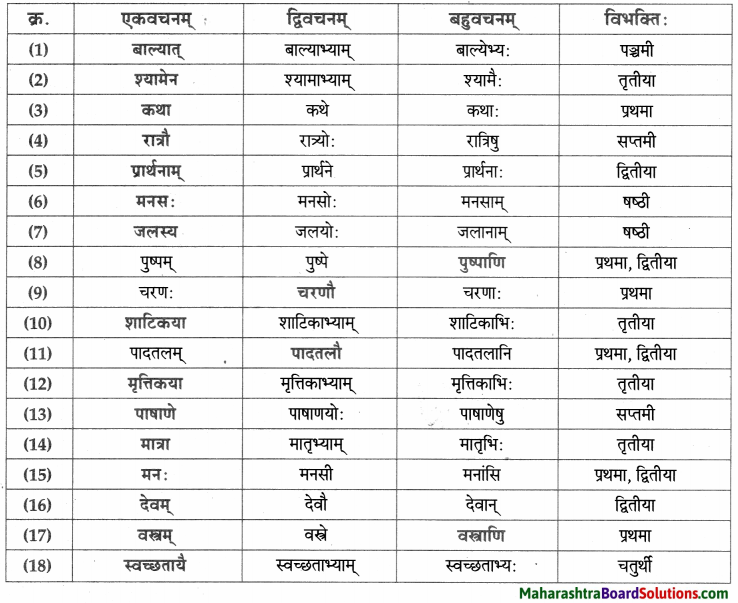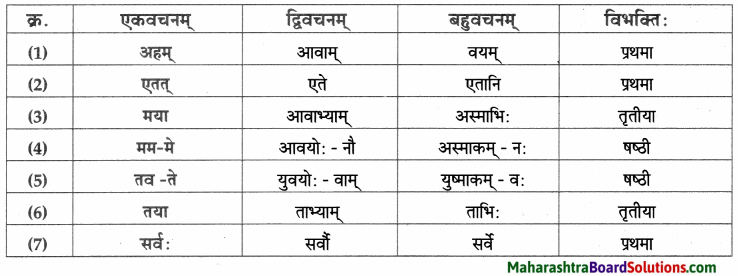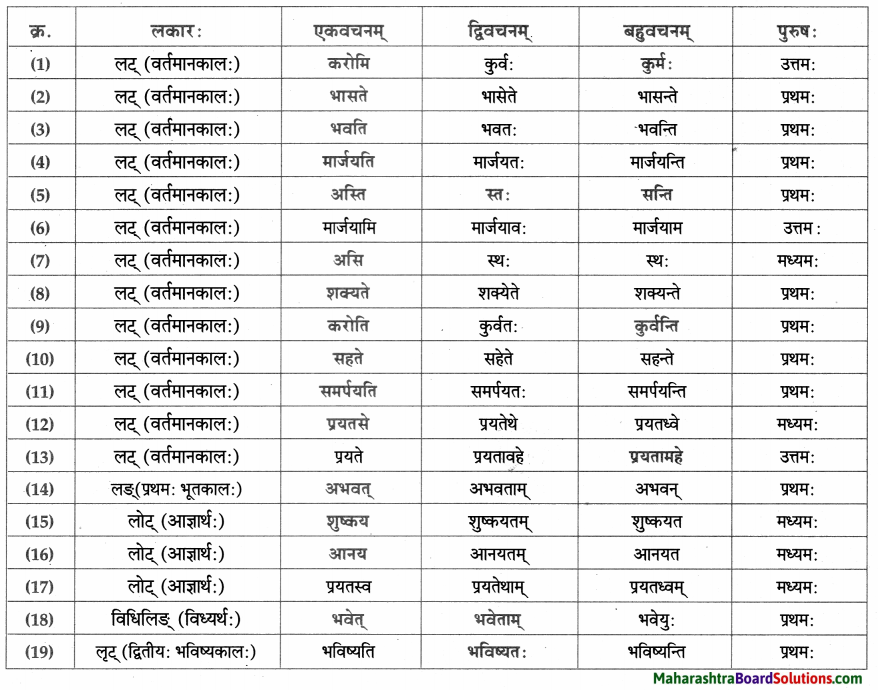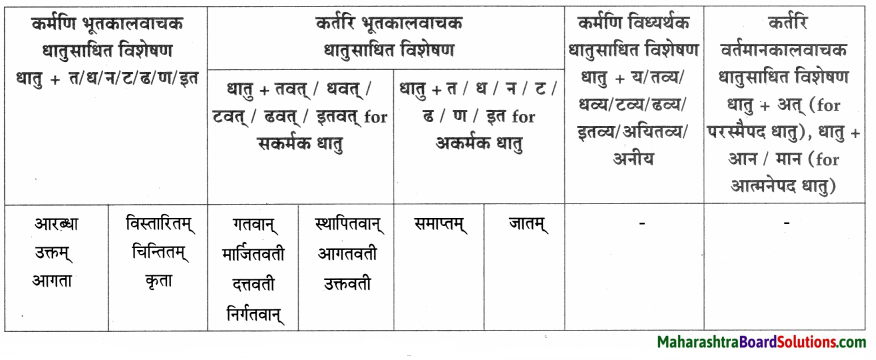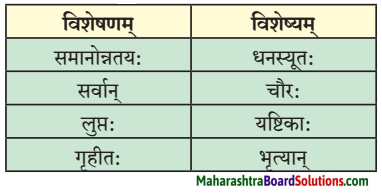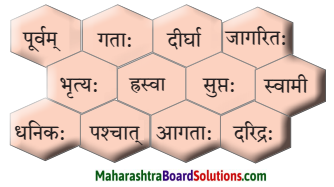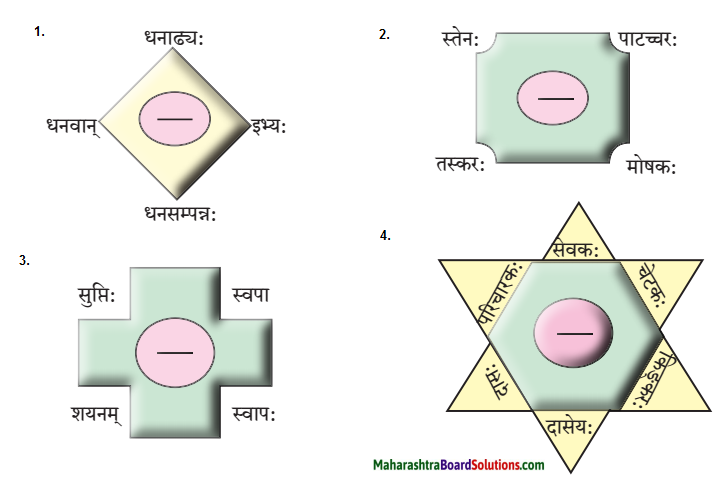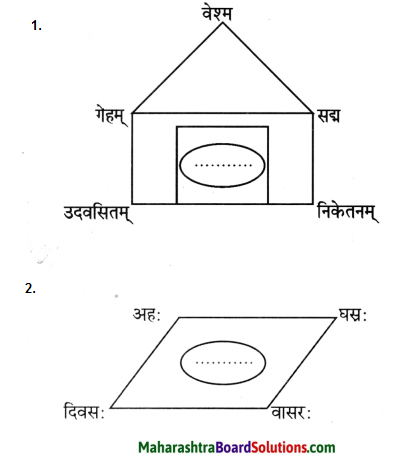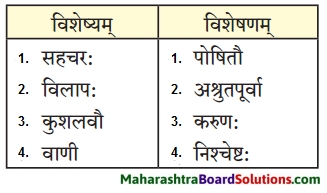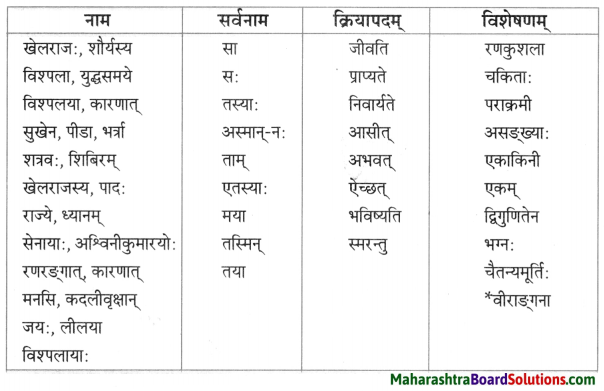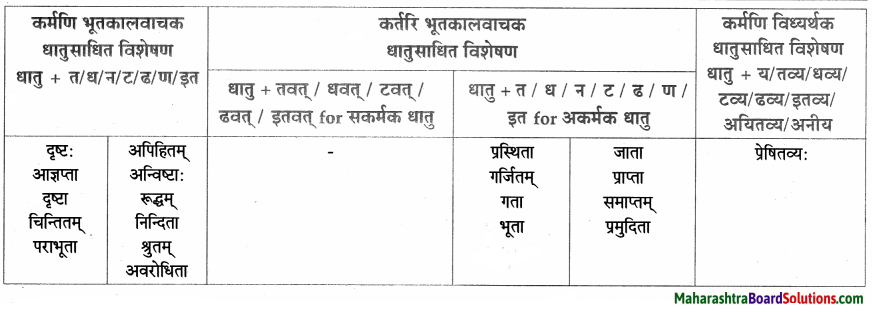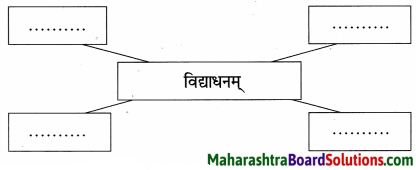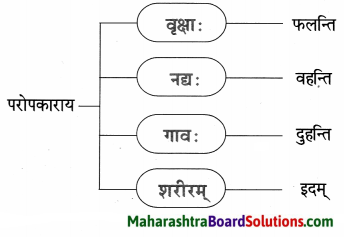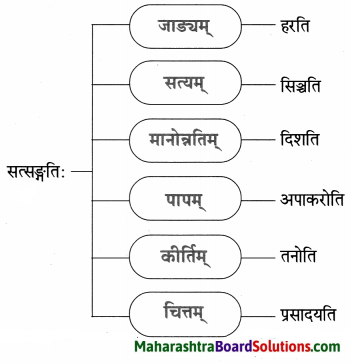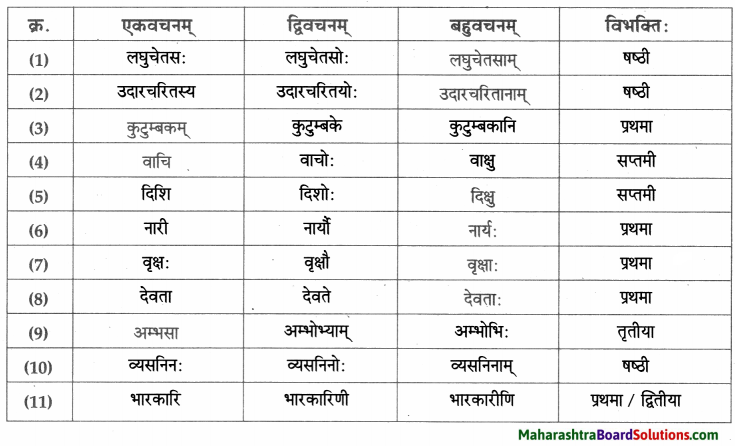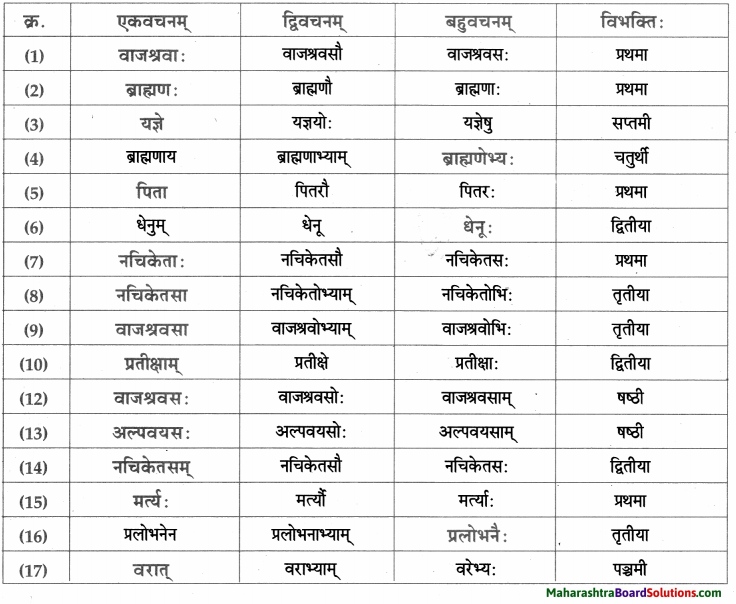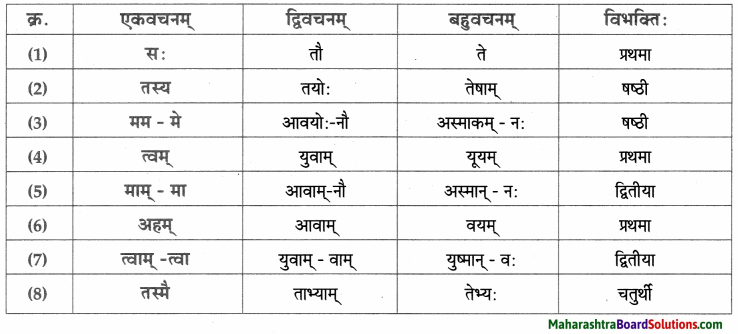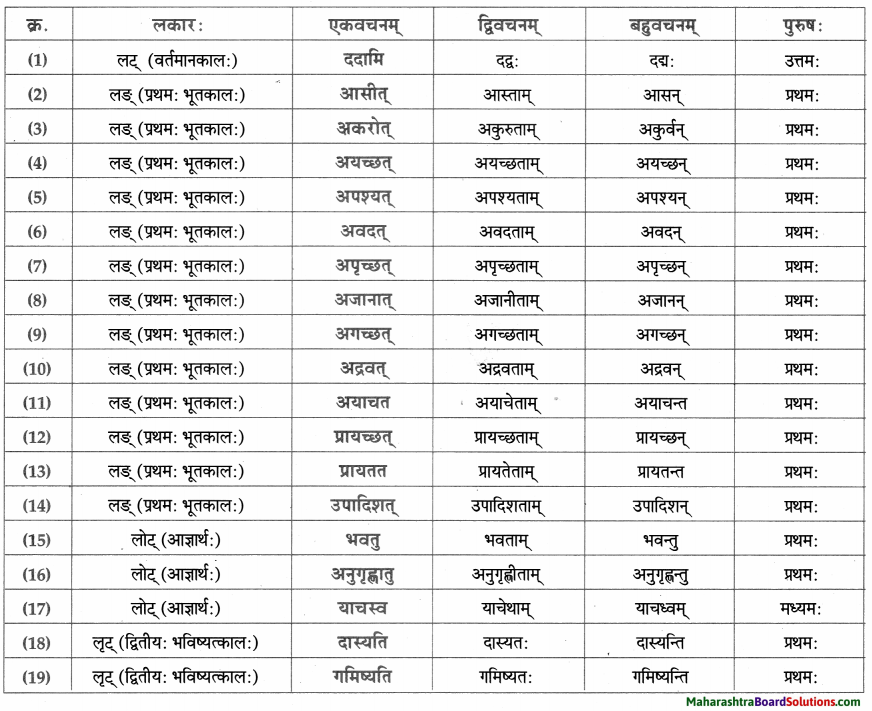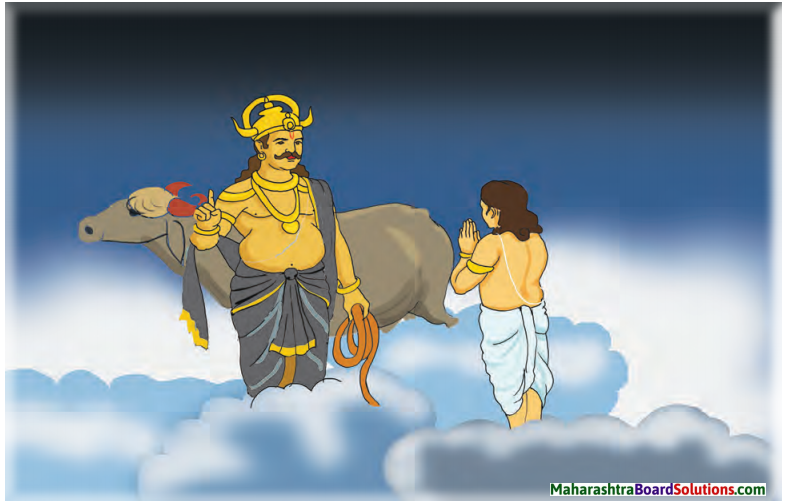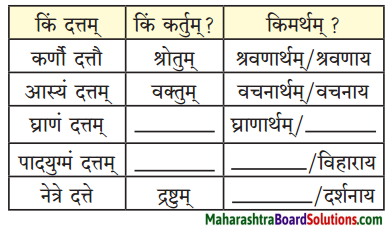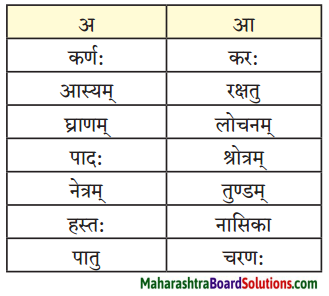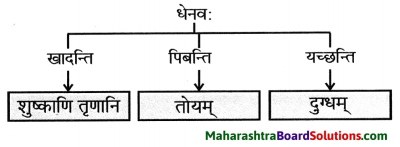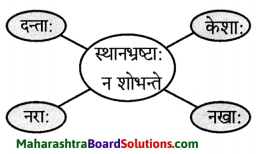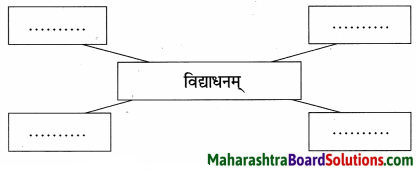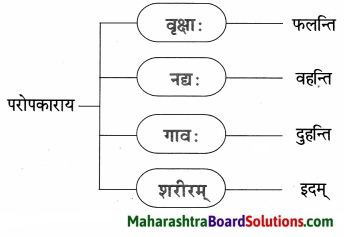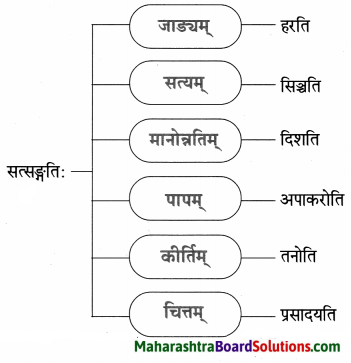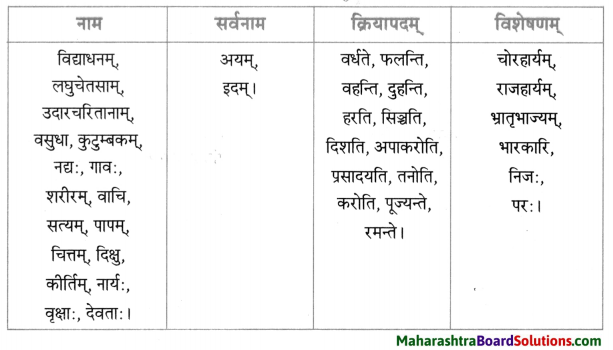Class 9th Sanskrit Anand Chapter 6 पिनकोड्प्रवर्तकः महान् संस्कृतज्ञः Question Answer Maharashtra Board
Balbharti Maharashtra State Board Class 9 Sanskrit Solutions Anand Chapter 6 पिनकोड्प्रवर्तकः महान् संस्कृतज्ञः Notes, Textbook Exercise Important Questions and Answers.
Std 9 Sanskrit Chapter 6 Question Answer
Sanskrit Anand Std 9 Digest Chapter 6 पिनकोड्प्रवर्तकः महान् संस्कृतज्ञः Textbook Questions and Answers
भाषाभ्यास:
1. उचितं पर्यायं चिनुत।
प्रश्न अ.
पत्रवाहक: किं पठित्वा पत्रं वितरति ?
1. देवनागरीलिपीम्
2. कन्नडलिपीम्
3. आङ्ग्लभाषाम्
4. सङ्केतक्रमाङ्कम्
उत्तरम् :
4. सङ्केतक्रमाङ्कम्
![]()
प्रश्न आ.
पिन्कोक्रमाङ्कः अत्र न आवश्यकः।
1. रुग्णालये
2. सद्यस्क-क्रयणे
3. ATM शाखा-अन्वेषणे
4. पुस्तकपठने
उत्तरम् :
4. पुस्तकपठने
प्रश्न इ.
पिनकोड्-प्रणालिः केन समारब्धा ?
1. इन्दिरामहोदयया
2. गान्धीमहोदयेन
3. प्रधानमन्त्रिणा
4. वेलणकरमहोदयेन
उत्तरम् :
4. वेलणकरमहोदयेन
प्रश्न ई.
पिनकोड्क्रमाङ्के कति सङ्ख्या:?
1. 6
2. 4
3. 3
4. 2
उत्तरम् :
1. 6
![]()
2. माध्यमा भाषाया लिखत।
प्रश्न 1.
वेलणकरमहोदयस्य कार्यवैशिष्ट्यानि लिखत।
उत्तरम् :
‘पिनकोड् प्रवर्तकः, महान् संस्कृतज्ञः’ या पाठात पत्रव्यवहार बिनचूक होण्यासाठी आवश्यक अशा पिन-कोड् प्रणालीविषयी माहिती मिळते. श्रीराम भिकाजी वेलणकर हे कलकत्ता पत्रविभागाचे संचालक म्हणून कार्यरत होते. त्यांच्याकडे एक सैनिक एक समस्या घेऊन आला.
त्याला आपल्या आई-वडिलांच्या तब्येतीविषयी माहिती कळत नव्हती कारण तो अरुणाचल प्रदेशात राहत होता व त्याचे आई – वडील केरळमध्ये, केरळहून अरुणाचलला पत्र पोहोचण्यास एक महिन्याहून अधिक काळ लागत असे. त्याची समस्या ऐकून वेलणकर महोदयांनी त्याची दखल घेतली व विचार सुरु केला.
त्यांनी सर्वप्रथम पत्रवाटप कार्यातील नेमकी समस्या जाणून घेतली. लिखाणातील संदिग्धतेमुळे समस्या निर्माण होते हे लक्षात घेऊन त्यांनी अंकाधारित पिनकोड पद्धत निर्माण केली. त्यासाठी त्यांनी देशाचे आठ भाग करून त्यांना राज्यनिहाय क्रमांक दिले.
अशाप्रकारे सहा अंकांचा स्थानसंकेतांक असणारी पिनकोड पद्धत त्यांनी भारतात सुरु केली. वेलणकर महोदय गणितज्ञ असल्यामुळे पत्रविभागातील कार्यातसुद्धा त्यांनी त्यांच्या गणित ज्ञानाचा कौशल्याने वापर केला. ते आपल्या कार्याशी प्रामाणिक व कर्तव्यदक्ष होते.
In the lesson ‘पिनकोड् प्रवर्तकः, महान संस्कृतज्ञ’ we get to know about a great mathematician and a dedicated sanskrit scholar Mr. Velankar who invented PIN Code System. Mr. Velankar was director of Kolkata post office.
Once a soldier came to him and told that he was facing a problem in getting information regarding his parents’ health as it used to take more than a month for a letter to reach Kerala from Arunachal Pradesh.
Hearing his problem Mr. Velankar immediately started to think about the solution. He first tried to analyse the reasons behind the problem. He realised that due to bad handwriting, incomplete address etc. such problems arise.
He then divided the country in eight and numbered these divisions based on the states. This number has six-digits. This sixdigit number is PIN code. He was a very efficient post office director and was very devoted to his work.
![]()
प्रश्न 2.
वेलणकरमहोदय: केन प्रसङ्गेन पिनकोडनिर्माणे प्रेरित:?
उत्तरम् :
‘पिनकोड् प्रवर्तकः, महान् संस्कृतज्ञः’ या पाठात पिनकोड प्रणाली कशी व कधी अस्तित्वात आली याबद्दल माहिती मिळते. श्रीराम वेलणकर हे कोलकता पोस्टविभागात कार्यरत होते. एके दिवशी अरुणाचलप्रदेशात राहणारा सैनिक दुःखी होऊन त्यांच्याकडे आला. अरुणाचलप्रदेशाहून केरळला पत्र जाण्यासाठी महिन्याभरापेक्षा अधिक वेळ लागत असे. त्यामुळे त्याला त्याच्या आई-वडीलांच्या तब्येतीविषयी कळत नव्हते.
त्या सैनिकाची समस्या ऐकून वेलणकरांनी त्यावर विचार करून त्यावर उपाय शोधण्याचा प्रयत्न सुरु केला व त्यातूनच पिनकोडपद्धती अस्तित्वात आली.
In the lesson ‘पिनकोड् प्रवर्तकः, महान संस्कृतज्ञ’, greatness of Mr. Velankar is described. Mr. Velankar was working in Kolkata post office as director. During his tenure, one soldier came to him. He was sad because he was unable to know about his parent’s health. He was on posting at Arunachat pradesh and his parents were staying in Kerala.
It used to take more than a month for a letter to reach Kerala from Arunachal pradesh. After listening to his problem. Mr. Velankar analysed tue reason behind this problem and eventually invented the PIN-code system.
A genuine problem of a solder drove Mr. Velankar to invent the PIN-code system.
![]()
3. एकवाक्येन उत्तरत।
प्रश्न अ.
वेलणकरमहोदयस्य कः प्रियः विषयः ?
उत्तरम् :
वेलणकरमहोदयस्य सङ्गीतं प्रिय: विषयः।
प्रश्न आ.
वेलणकरमहोदयः के वाद्ये वादयति स्म ?
उत्तरम् :
वेलणकरमहोदयः व्हायोलिन तबला च इति वाद्ये वादयति स्म।
![]()
प्रश्न इ.
वेलणकरमहोदयेन रचितः सङ्गीतविषयकः ग्रन्थः कः ?
उत्तरम् :
वेलणकरमहोदयः रचितः सङ्गीतविषयक: ग्रन्च: गीतगीर्वाणम्।
प्रश्न ई.
पिनकोड्प्रणालिनिमित्तं वेलणकरमहोदयेन देशस्य कति विभागाः कृताः ?
उत्तरम् :
पिनकोप्रणालिनिमित्तं वेलणकरमहोदयेन देशस्य अष्ट विभागा: कृताः ।
प्रश्न उ.
वेलणकरमहोदयः कस्य विभागस्य निर्देशकः आसीत् ?
उत्तरम् :
वेलणकरमहोदयः डाकतारविभागस्य निर्देशकः आसीत्।
प्रश्न ऊ.
वेलणकरमहोदयस्य अभिमतः साहित्यप्रकार: कः?
उत्तरम् :
वेलणकरमहोदयस्य अभिमतः साहित्यप्रकार: नाट्यलेखनम्।
![]()
5. विशेषणानि अन्विष्य लिखत।
प्रश्न 1.
अ. ………………. प्रणालिः।
आ. …………… सैनिकः ।
इ. ………………. भाषाः।
ई. ………………. हस्ताक्षरम् ।
ए. ………………. विषयः।
ऐ. ………………. रचनाः।
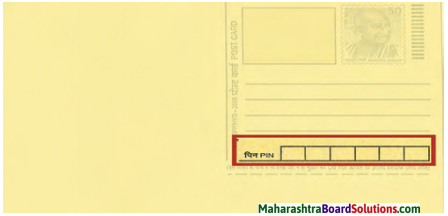
उत्तरम् :
आ. दुःखितः, केरलं प्रदेशीयः
इ. भिन्ना:
ई. दुबोधम्
ए. प्रियः
ऐ. विविधाः
![]()
अन्विष्यत लिखत च।
1. एताः सङ्ख्याः किं निर्दिशन्ति।

2. विविधदेशेषु अपि पत्रसङ्केताङ्कप्रणालिः वर्तते वा?
Sanskrit Anand Class 9 Textbook Solutions Chapter 6 पिनकोड्प्रवर्तकः महान् संस्कृतज्ञः Additional Important Questions and Answers
उचितं पर्यायं चिनुत ।
प्रश्न 1.
…………. प्रधानमन्त्रिमहोदयायै कदा उपहारीकृता एषा पिन्कोड् महत्त्वपूर्णा प्रणालि:?
(अ) ऑगस्ट 1972
(आ) ऑगस्ट 1929
(इ) सप्टेंबर 1972
(ई) ऑगस्ट 1927
उत्तरम्
(अ) ऑगस्ट 1972
प्रश्ननिर्माणं कुरुत।
प्रश्न 1.
1. पत्रालय-अधिकारी संस्कृतपण्डितः गणितज्ञः श्रीराम भिकाजी वेलणकरमहोदयः।
2. वयं पत्रपेटिकायां पत्रं क्षिपामः।
उत्तरम्
1. पत्रालय-अधिकारी क: अस्ति?
2. वयं कुत्र पत्रं क्षिपाम:?
![]()
उचितं पर्यायं चित्वा वाक्यं पुनर्लिखत ।
प्रश्न 1.
- वेलणकरमहोदय: डाकतार-विभागस्य निर्देशकरूपेण ………. आसीत्। (कार्यविभागे / कार्यमग्नः)
- पत्रस्य प्रवासकाल: ……… आसीत्। (मासः / मासाधिक:)
- वेलणकरमहोदयेन ……… अङ्कानाम् उपयोगः कृतः? (शास्त्रज्ञेन / गणितज्ञेन)
- वेलणकरमहोदयस्य प्रियविषयः ……… आसीत्। (सङ्गीतम् / इतिहास:)
- ……….. ख्याति: नाटकानाम् आसीत्। (सबकुछ श्रीः / सबकुछ श्रीभिः)
उत्तरम् :
- कार्यमग्नः
- मासाधिकः
- गणितज्ञेन
- सङ्गीतम्
- सबकुछ श्रीभिः
एकवाक्येन उत्तरत।
प्रश्न 1.
कः कोलकतानगरे कार्यरतः आसीत्?
उत्तरम् :
श्रीराम-भिकाजी-वेलणकरमहोदय : कोलकतानगरे कार्यरतः आसीत्।
![]()
प्रश्न 2.
वेलणकरमहोदयस्य कार्यकाले क: आगतः?
उत्तरम् :
वेलणकरमहोदयस्य कार्यकाले केरल-प्रदेशीयः सैनिक: मेलितुम् आगतः।
प्रश्न 3.
वेलणकरमहोदयस्य चिन्तनं किम् आसीत्?
उत्तरम् :
“कश्यं पत्रस्य प्राप्तिकालं न्यूनं कर्तुं शक्नोमि?” इति वेलणकरमहोदयस्य चिन्तनम् आसीत्।
प्रश्न 4.
वेलणकरमहोदयेन केषाम् उपयोगः कृतः?
उत्तरम् :
वेलणकरमहोदयेन अङ्कानाम् उपयोगः कृतः।
प्रश्न 5.
वेलणकरमहोदयः कस्मिन् वादने निपुण: आसीत्?
उत्तरम् :
वेलणकरमहोदयः व्हायोलिनवादने तथा तबलावादनेऽपि निपुणः आसीत्।
![]()
प्रश्न 6.
वेलणकरमहोदयः किं रचितवान् ?
उत्तरम् :
वेलणकरमहोदयः गीतगीर्वाणम् इति सङ्गीतविषयकं शास्त्रीयग्रन्थं रचितवान्।
प्रश्न 7.
पत्राणाम् वितरणव्यवस्था कथं शक्या भवति?
उत्तरम् :
पत्राणां वितरणव्यवस्था पिनकोड्प्रणाल्या शक्या भवति।
प्रश्न 8.
एषा महत्त्वपूर्णा प्रणालिः कस्यै उपहारीकृता?
उत्तरम् :
एषा महत्त्वपूर्णा प्रणालि: प्रधानमन्त्रि-इन्दिरा-गान्धी महोदयायै उपहारीकृता।
प्रश्न 9.
पिन्कोक्रमाङ्के कति सङ्ख्या:?
उत्तरम् :
पिन्कोक्रमाङ्के षट् सङ्ख्याः ।
![]()
सत्यं वा असत्यं लिखत।
प्रश्न 1.
- पत्रस्य प्रवासकाल: मासाधिको नासीत्।
- अधुनापि वयं विनायासं शीघ्र पत्र लभामहे।
- वेलणकर: महोदयः न अनुशासनप्रियः ।
- वेलणकरमहोदयः सर्वमेव कर्तुं न समर्थः ।
- पत्रालयात् निर्दिष्टं स्थानं प्रति पत्राणि गच्छन्ति।
- पत्रलस्य अधिकारी संस्कृतपण्डितः शास्त्रज्ञः च।
उत्तरम् :
- असत्यम्
- सत्यम्
- असत्यम्
- असत्यम्
- सत्यम्
- असत्यम्
![]()
शब्दस्य वर्णविग्रहं कुरुत।
- दुर्बोधम् – द् + उ + र् + ब् + ओ + ध् + अ + म् ।
- विनायासम् – व् + इ + न् + आ + य् + आ + स् + अ + म्।
- क्रमाङ्कनम् – क् + र् + अ + म् + आ + ङ् + क् + अ + न् + अ + म्।
- कर्तुम् – क् + अ + र + त् + उ + म्।
- विद्वद्वरेण्यः – व् + इ + द् + व् + अ + द् + व् + अ + र + ए + ण् + य् + अः।
- प्राप्नोति – प् + र + आ + प् + न् + ओ + त् + इ।
- महोदयायै – म् + अ + ह् + ओ + द् + अ + य् + आ + य् + ऐ।
- प्रणालिः – प् + र् + अ + ण् + आ + ल् + इ:।
विभक्त्यन्तरूपाणि।
- प्रथमा – मित्राणि, वयम्, एषा, सः, विभागाः, सैनिकः, वयम्, प्रत्यूहाः, नैके, वयम्, रचनाः, गीतानि, कथाः, साहित्यप्रकारः।
- द्वितीया – पत्रालयः, स्थानम्, पत्रम्, नाट्यलेखनम्, सर्वम्, दिग्दर्शनम्।
- तृतीया – केन, निर्देशकरूपेण, तेन, संस्कृतेन, तेन, येन।
- षष्ठी – अस्माकम्, एतस्य, प्रश्नस्य, डाकतारविभागस्य, पत्रस्य, तेषाम् पित्रोः, तस्य, नाटकानाम्।
- सप्तमी – देशे, पत्रपेटिकायाम्, कोलकतानगरे, एकस्मिन, दिने।
![]()
त्वान्त/ल्यबन्त/तुमन्त अव्ययानि।
| त्वान्त अव्यय धातु + त्वा / ध्वा / ट्वा / ढ्वा / इत्वा अयित्वा | ल्यबन्त अव्यय उपसर्ग + धातु + य / त्य | तुमन्त अव्यय थातु + तुम् / धुम् / टुम् / ढुम् / इतुम् / अयितुम् |
| – | – | मेलितुम् |
| – | – | ज्ञातुम् |
| – | – | कर्तुम् |
विशेषण – विशेष्य – सम्बन्धः
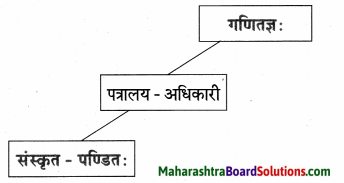
प्रश्न 1.
……… साहित्यप्रकारः।
उत्तरम् :
अभिमतः
![]()
पिनकोड्प्रवर्तकः महान् संस्कृतज्ञः Summary in Marathi and English
प्रस्तावना :
आजच्या इंटरनेट युगात आपण पत्रव्यवहार कमी करत असलो तरीसुद्धा आजही भारतामध्ये पत्रविभाग हा महत्वाचा प्रशासकीय विभाग आहे. ह्य विभाग ज्या प्रणालीमुळे गेली अनेक वर्षे अव्याहतपणे चालू आहे ती पिनकोड प्रणाली पत्र-व्यवहाराचा आधार आहे. प्रस्तुत गद्यांश वेलणकर महोदयांनी प्रचलित केलेल्या पिनकोड प्रणाली विषयी माहिती देतो.
वेलणकर महोदय हे श्रेष्ठ गणितज्ञ तसेच संस्कृत विषयाचे गाढे अभ्यासक होते. त्यांनी अनेक संस्कृत नाटके, काव्ये रचली. सङ्गीतसौभद्रम् कालिदासचरितम्, जन्म रामायणस्य, तनयो राजा भवति कथं मे? राज्ञी दुर्गावती, रणश्रीरङ्गम्, कालिन्दी, स्वातन्त्र्यलक्ष्मीः, कौटिलीयार्थनाट्यम् या त्यांच्या काही सुप्रसिद्ध रचना आहेत.
Even though in the era of ‘e-mail’, we are not much acquainted with writing the traditional letter, in India postal service is still one of the most important pillars of the administrative system. PIN-code system is unique feature of this service.
This system was invented by Mr. Velankar, He was a great mathematician and Sanskrit scholar. He has composed several Sanskrit poems, plays etc. Torname a fear सङ्गीतसौभद्रम्,कालिदासचरितम्, जन्म रामायणस्य,तनयो राजा भवति कथं मे? राज्ञी दुर्गावती, रणबीरङ्गम् कालिन्दी, स्वातन्त्र्यलक्ष्मी:, कौटिलीयार्थनाट्यम् are his popular compositions.
![]()
उपोद्घात:
- गौरवः – अरे अमेय, कुछ गच्छसि?
- अमेयः – समीपे एव पत्रपेटिका वर्तते। मातुलं प्रति पत्रं प्रेषयितुं तत्र गच्छामि।
- गौरवः – दर्शय पत्रम्। अपि बेङ्गलुरुनगरे निवसति तव मातुल:? तत् तु अतीव दूरे किल? कदा पत्रं विन्देत् स:?
- अमेयः – सामान्यत: त्रीणि दिनानि अपेक्षितानि तदर्थम्।
- गौरवः – जीणि दिनानि एव? एतावत् शीघ्रम्?
- अमेयः – सत्यम्।
- गौरवः – किन्तु सङ्केत: तु देवनागरीलिप्यां लिखितः। कर्णाटके तु कन्नडलिपिः प्रयुज्यते नु? तहि कथं पत्रवाहकः तत् पठितुं शक्नुयात्?
- अमेयः – पश्य एतत्। सङ्केतस्य अन्ते आङ्ग्लभाषया कश्चन क्रमाङ्क: लिखितः अस्ति। जानासि खलु तद्विषये?
- गौरवः – आम, सः तु पिन्कोक्रमाङ्कः । अहं पत्रं न लिखामि किन्तु सद्यस्क – क्रयणसमये (Online Shopping) पिन्कोक्रमाङ्क: अनिवार्यः एव। इतोऽपि च अस्माकं विभागे ATM शाखाः, रुग्णालयाः, विशिष्टसेवा: वा कुत्र सन्ति इति ज्ञातुं पिन्कोक्रमाङ्क: आवश्यक: एव।
- गौरव – अरे अमये, कुठे जात आहेस?
- अमेय – जवळच टपालपेटी आहे. मामाला पत्र पाठविण्यासाठी तिथे जात आहे.
- गौरव – पत्र दाखव, तुझा मामा बंगळुरूला राहतो का? ते तर खूप दूर आहे ना? त्याला पत्र केव्हा मिळेल?
- अमेय – साधारणपणे त्यासाठी तीन दिवस लागतात.
- गौरव – केवळ तीनच दिवस? एवढ्या लवकर?
- अमेय – खरेच.
- गौरव – परंतु पत्ता तर देवनागरी लिपीमध्ये लिहिलेला आहे. कर्नाटकात तर कन्नड लिपी वापरली जाते ना? तर मग टपालवाहकाला ते वाचणे कसे शक्य होईल?
- अमेय – हे बघ. पत्त्याच्या शेवटी इंग्रजी भाषेत काही क्रमांक लिहिलेले आहेत. त्याविषयी काही माहिती आहे का?
- गौरव – हो, तो तर पिनकोड क्रमांक आहे. मी पत्र लिहीत नाही परंतु ऑनलाईन शॉपिंग करतेवेळी पिनकोड क्रमांक अनिवार्यच आहे. आपल्या विभागातील ATM शाखा, रुग्णालये अथवा विशिष्ट सेवा कुठे आहेत हे जाणून घेण्यासाठी पिनकोड क्रमांक आवश्यकच आहे.
- Gaurav – Ameya, where are you going?
- Ameya – I have a post box near by. I am going there to send the letter to my uncle.
- Gaurav – Show me the letter! Does your uncle live in Bengaluru city? That is really far, isn’t it? When will he get the letter?
- Ameya – Generally two three days are expected for that.
- Gaurav – Just three days? So fast?
- Ameya – Yes, true!
- Gaurav – But the address is written in Devnagari. But in Karnataka, Kannada script is used, right? Then how would the postman be able to read it?
- Ameya – See this. At the end of the address, a certain number is written. Do you know about that?
- Gaurav – Yes, that is the PIN code number. I do not write a letter, but while shopping online, PIN-code number is necessary. Apart from this, to know where ATM branches, hospitals or any special services are, it is essential to know the PIN code number.
![]()
परिच्छेद : 1
अयि मित्राणि, ………… वेलणकरमहोदयः।
अयि मित्राणि, भारतसदृशे विशाले देशे सुदूरपान्तेभ्यः अन्यप्रान्तं प्रति प्रेषितानि पत्राणि बिना विलम्बं विना प्रमादं कथं लभ्यन्ते ? वयम् अस्माकं निवासविभागे पत्रपेटिकायां पत्रं क्षिपामः । तत: तत् पत्रालयं प्रति गच्छति। तत: च निर्दिष्टं स्थानं प्रति प्राप्नोति। कथं शक्या भवति एषा वितरणव्यवस्था? “पिन्कोमणालिः’ इत्येव एतस्य प्रश्नस्य उत्तरम्। पिन्कोक्रमाङ्कः नाम पत्रसङ्केतस्य अन्ते लिखिताः षट् सङ्ख्याः । पिनकोड् नाम स्थानसङ्केताङ्कः ।
(PIN – Postal Index Number), ऑगस्ट 1972 – तमे खिस्ताब्दे स्वातन्त्र्यदिनसमारोहे प्रधानमन्त्रि-इन्दिरा-गान्धी-महोदयायै उपहारीकृता एषा महत्वपूर्णा प्रणालिः । केन खलु प्रवर्तिता इयं सङ्केताङ्कप्रणालिः? स: पत्रालय-अधिकारी आसीत् संस्कृतपण्डित: गणितज्ञः श्रीराम-भिकाजी-वेलणकरमहोदयः।
अनुवादः
अहो मित्रहो, भारतासारख्या विशालदेशात दूरवरच्या प्रांतातून इतर प्रांतात पाठवलेली पत्रे उशीर न होता व कोणत्याही चुकीशिवाय कशी बरे मिळतात? निवास विभागातील टपालपेटीत पत्र टाकतो. त्यानंतर ते पत्रालयात जाते. आणि तिथून निर्दिष्ट केलेल्या स्थळी पोहोचते. ही वितरणव्यवस्था कशी शक्य होते?
“पिनकोड्पद्धत’ हेच या प्रश्नाचे उत्तर, पिनकोड क्रमांक म्हनजे पत्रावरील पत्त्याच्या शेवटी लिहिलेल्या सहा संख्या होय, पिनकोड म्हणजे स्थानसंकेतांक (स्थानाचा निर्देश करणारे विशिष्ट अंक) ऑगस्ट 1972 रोजी स्वातंत्र्यदिनाच्या समारंभाला भेट केलेली ही महत्त्वपूर्ण प्रणाली आहे. ही संकेतांक प्रणाली कोणी बरे निर्माण केली? ते पत्रालय-अधिकारी होते. संस्कृतपंडित, गणितज्ञ श्रीराम भिकाजी वेलणकरमहोदय.
O friends, in a huge country like India, how do letters sent from far-flunged region to other places reach without delay and without errors? We drop the letter in a post box, which is there in our residential area. Then it goes to the post office.
And then reaches the place indicated. How does this distribution system become possible? ‘PIN-code system’ is the answer to this question. PIN-code number means the six digits written at the end of the letter’s address. PIN-code means Postal Index Number.
This system handed over to the Prime Minister Indira Gandhi in August 1972 on the occasion of the Independence Day, However, who invented this PIN-code system? That post-office officer was a Sanskrit scholar and mathematician Mr. Shriram Bhikaji Velankar.
![]()
परिच्छेद : 2
स: कोलकतानगरे ……………… लभामहे ।
स: कोलकतानगरे डाकतारविभागस्य निर्देशकरूपेण कार्यरतः आसीत् । तस्य कार्यकाले एकस्मिन् दिने कोऽपि दुःखितः केरल-प्रदेशीयः सैनिक: महोदयं मेलितुम् आगतः । सः तस्य पित्रो: स्वास्थ्यविषये किञ्चिदपि ज्ञातुम् असमर्थः । यतः तदा पत्रस्य प्रवासकालः केरलत:अरुणाचलप्रदेशपर्यन्त क्वचित् मासाधिकोऽपि आसीत्।
तेन पं. वेलणकरमहोदयस्य चिन्तनम् आरब्धम्, ‘कथं पत्रस्य प्राप्तिकालं न्यून कर्तुं शक्नोमि ? दुर्बोध हस्ताक्षरं, भिन्नाः प्रान्तीया: भाषा:, अपूर्णः पत्रसङ्केत: इति नैके प्रत्यूह्यः । अत: गणितज्ञेन तेन अङ्कानाम् उपयोगः कृतः । तेन देशस्य अष्ट विभागाः कृताः । तेषां च उपविभाग-जनपदाधारण क्रमाङ्कनं कृतम्। तेन अधुनापि वयं विनायासं शीघ्र पत्रं लभामहे।
अनुवादः
ते कोलकतानगरात डाकतार विभागाचे निर्देशक म्हणून कार्यरत होते. त्यांच्या कार्यकाळात एके दिवशी कोणी एक दुःखी केरळ प्रदेशातील सैनिक (त्या) महोदयांना भेटण्यासाठी आला. तो त्याच्या आई-वडिलांच्या स्वास्थाविषयी अजिबात जाणून घेऊ शकत नव्हता. कारण तेव्हा पत्राचा प्रवासकाळ केरळपासून अरुणाचलप्रदेशापर्यंत एक महिन्याहूनही अधिक होता.
त्यामुळे पं, वेलणकर महोदयांनी विचार करण्यास सुरुवात केली, पत्र पोहचण्याचा काळ कसा बरे कमी करता येईल?’ दुर्बोध (समजण्यासाठी कठीण) हस्ताक्षर, वेगवेगळ्या प्रांतातील वेगवेगळ्या भाषा, अपूर्ण पत्ते अशा अनेक समस्या होत्या.
म्हणून गणितज्ञ असलेल्या त्यांनी अंकांचा उपयोग केला. त्यांनी देशाचे आठ विभाग पाडले. आणि त्यांचे उपविभाग, राज्यांच्या आधाराने क्रमांकन केले. त्यामुळे आत्तासुद्धा आपल्याला विनासायास (सहजपणे) त्वरित पत्र मिळते.
He worked as the director of postal department at Kolkata. During his tenure, a certain grieved soldier who was native of Kerala came to meet Mr. Velankar. He was totally unable to know about his parent’s health Because at that time, travelling time of a letter from Kerala to Arunachal Pradesh was sometimes even more than a month.
Hence, Mr. Velankar started thinking ‘how can I reduce the time for the letter to reach? There are many obstacles like bad handwriting, different regional languages, incomplete address etc. Hence, the digits were used by that mathematician.
He made eight divisions of the country, They were numbered on the basis of subdivision states. Because of that, we still get the letter fast without much effort.
![]()
परिच्छेद : 3
अनुशासनप्रियस्य …………… उपकृताः ।
अनुशासनप्रियस्य वेलणकरमहोदयस्य सङ्गीतमपि प्रियः विषयः । स: व्हायोलिनवादने तथा तबलावादनेऽपि अतीव निपुणः। अतः एव सः ‘गीतगीर्वाणम् इति सङ्गीतविषयक शास्त्रीयग्रन्थं संस्कृतेन रचितवान्। कथाः, गीतानि, बालगीतानि, नृत्यनाट्यम् इति बहुविधाः रचना: तेन कृताः तथापि नाट्यलेखन तस्य अभिमत: साहित्यप्रकार: ।
लेखन, दिग्दर्शनं, नाट्यनिर्मितिः, व्यवस्थापन, सङ्गीतसंयोजनम् इति सर्वमेव कर्तुं सः समर्थः अत: “सबकुछ श्रीभिः” इति तस्य नाटकानां ख्यातिः आसीत्। धन्यः सः विद्रद्वरेण्यः येन वयं पिनकोड्प्रणाल्या उपकृताः।
अनुवादः
शिस्तप्रिय वेलणकर महोदयांचा संगीत सुद्धा आवडता विषयोता. ते व्हायोलिनवादनात तसेच तबला वादनातही अतिशय पारंगत होते. म्हणूनच त्यांनी ‘गीतगीर्वाणम्’ हा संगीत विषयक शास्त्रीय ग्रंथ संस्कृतात रचला. कथा, गाणी, बालगीते, नृत्यनाट्य अशा पुष्कळ रचना त्यांनी केल्या. तरी नाट्यलेखन त्यांचा आवडता साहित्य प्रकार होता.
ते लेखन, दिग्दर्शन, नाट्यनिर्मिती, व्यवस्थापन, संगीतसंयोजन हे सर्व काही करु शकत म्हणून “सबकुछ श्रीभिः” अशी त्यांच्या नाटकांची ख्याती होती. धन्य ते श्रेष्ठ विद्वान (वेलणकर महोदय) ज्यांनी आपल्याला पिनकोडप्रणालीने उपकृत केले.
Mr. Velankar who liked discipline was also fond of music He was expert in playing the violin and tabla. Hence, he even composed a book, in Sanskrit “गीतगीर्वाणम्” which is related to music. He has composed many songs, songs for kids, danceplays and many compositions, yet play-writing was his favorite literature genre.
He was able to do writing, direction, production of dramas, management and music composition and hence his plays were famous as ‘सबकुछ श्रीभि:’. He was a great scholar who has indebted us with PINcode system.
![]()
सन्धिविग्रहः
- इत्येव – इति + एव ।
- कोऽपि – कः + अपि ।
- किञ्चिदपि – किचित् + अपि ।
- मासाधिकोऽपि – मासाधिक: + अपि ।
- अधुनापि – अधुना + अपि ।
- तबलावादनेऽपि – तबलावादने + अपि ।
- तथापि – तथा + अपि ।
- सर्वमेव – सर्वम् + एव ।
![]()
समानार्थकशब्दाः
- मित्राणि – वयस्याः।
- नाम – अभिधानम्।
- देशे – राष्ट्रे।
- ख्रिस्ताब्दे – संवत्सरे।
- रतः – मग्नः ।
- दिने – दिवसे।
- जनकः – पिता।
- समयम् – कालः।
- अधुना – इदानीम्।
- नुिपणः – पारङ्गतः।
- ग्रन्थः – पुस्तकम्।
- ख्यातिः – प्रसिद्धिः।
![]()
विरुद्धार्थकशब्दाः
- मित्राणि × रिपवः।
- पण्डितः × मूढः।
- अन्ते × आरम्भे।
- विशाल: × लघुः।
- शक्या × अशक्या।
- दुःखितः × आनन्दितः।
- असमर्थः × समर्थः।
- न्यूनम् × बहु, दीर्घम्।
- उपयोग: × निरुपयोगः।
- शीघ्रम् × शनैः शनैः।
- प्रियः × अप्रियः।
- समर्थम् × असमर्थम्।
![]()
शब्दार्थाः
- विलम्ब: – delay – उशीर
- प्रमादः – mistake – चूक
- पत्रपेटिकायाम् – in letter box – पत्रपेटीत
- क्षिपाम: – we drop – टाकतो
- उपहारीकृता – handed over to – सुपूर्द करणे
- प्रणालिः – system – प्रणाली, पद्धती
- गणितज्ञः – mathematician – गणितज्ञ
- कार्यरतः – engrossed in work – कार्यरत
- पित्रोः – parents – आई-वडिलांचे
- असमर्थः – unable – असमर्थ
- दुर्बोधम् – difficult to understand – अवघड
- विनायास – easily, without effort – सहजपणे
- निपुणः – expert – निपुण
- अभिमतः – favourite – आवडता
- ख्यातिः – fame, popularity – प्रसिद्धी
- विद्वद्वरेण्यः – great scholar – श्रेष्ठ विद्वान
- उपकृताः – blessed, indebted – उपकृत
- रचितवान् – composed – रचले
9th Standard Sanskrit Anand Digest Pdf
- सुष्ठु गृहीतः चौरः Class 9 Question Answer
- अव्ययमाला Class 9 Question Answer
- किं मिथ्या ? किं वास्तवम् ? Class 9 Question Answer
- विध्यर्थमाला Class 9 Question Answer
- वीरवनिता विश्पला Class 9 Question Answer
- पिनकोड्प्रवर्तकः महान् संस्कृतज्ञः Class 9 Question Answer
- सूक्तिसुधा Class 9 Question Answer
- मनसः स्वच्छता Class 9 Question Answer
- अमरकोषः Class 9 Question Answer
- काव्यशास्त्रविनोदः Class 9 Question Answer
- मनोराज्यस्य फलम् Class 9 Question Answer
